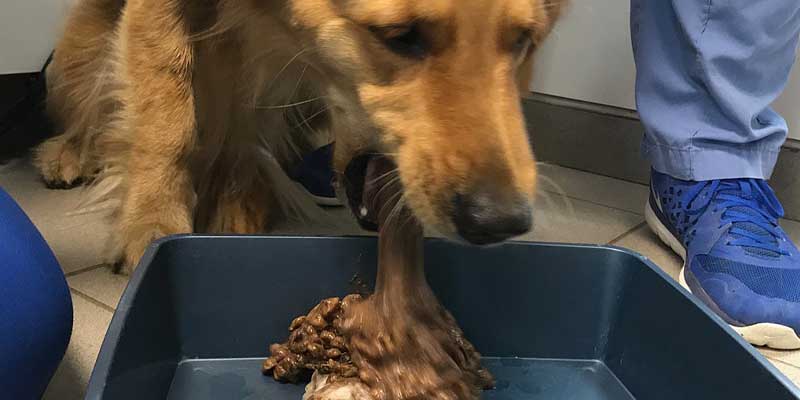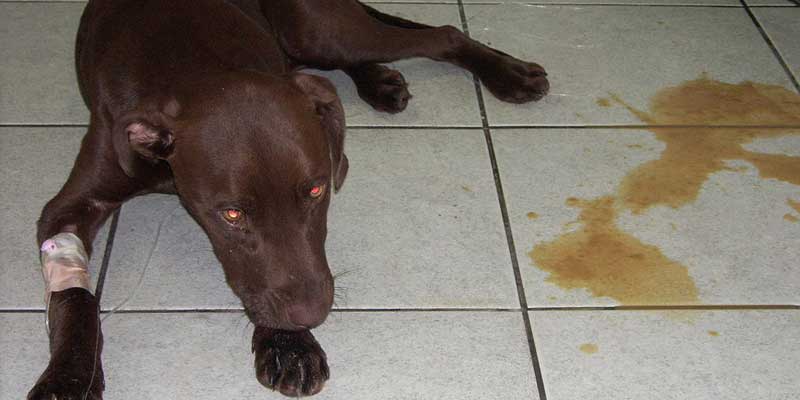
Before getting into the medical or non-medical causes of your dog’s vomiting, the first area of concern should be, “Is it even that serious to worry?”
Best Selling Dog Treats
Last update on 2025-07-17 / Affiliate links / Images from Amazon Product Advertising API
Being a new parent knows this, vomiting instantly after eating or vomiting 2-3 times a day is not something to worry about. It happens when they ingest something that should not be ingested, and if you are old parents, you might have seen several episodes of vomiting in your pup’s life.
Whether it’s a serious underlying thread that caused vomiting in a dog or just an ordinary food-allergic puking, we need to know our first aid to decode and treat the condition first.
Here is how we will decode the truth and treat it accordingly.
IDENTIFYING THE CAUSE OF VOMIT:
CHECK THE FREQUENCY:
It checks how frequently your dog is vomiting in a day, an hour, or 6 hours. Noticing and noting it down will help you get an idea of the severity that’s causing antiperistalsis.
Suppose it’s spontaneous reflux, vomiting right after they have eaten something before it even reaches the stomach. In that case, it’s just a normal “Regurgitation,” a response caused by the food ingestion if it shouldn’t be taken, have a bitter taste, or your dog doesn’t like it at all.
If it’s frequent and occurs more than 3 to 4 times a day or continues the same pattern for a week.
Frequent or abnormal regurgitation can also indicate medical conditions like hypothyroidism, abnormal nerve function, and myasthenia gravis. Call the vet for an appointment at your earliest leisure.
CHECK THE COLOR AND PRESENCE OF FOAM:
The color of vomit will help you big time identifying whether you got to rush to the hospital as soon as possible or you can wait for another episode to be sure enough. I know its gross to see or even think of evaluating a vomit, but when it’s about your pup’s health, you, just like me, will be up for anything that can save them from any upcoming serious health threats. There could be a variety of colors that can be seen as an indication of various medical conditions, e.g. (Green-yellow) or (reddish brown-black).
The green and yellow color(Bile from the liver) with a foamy vomit texture usually indicates the HCL (stomach acid) buildup. Color can also indicate grass, leaves, or plant material eating. It usually happens when they are sick or need attention if bored.
The reddish colors or brown can be a bit serious as it can indicate the injury that caused blood to leak out in a vomit. Injury in the Gastro-Intestinal tract or inflammation in the stomach due to poison can cause blood to leak out when your dog vomits.
A dark brown color can either tell you if he has eaten a bar of chocolate or feces from a sidewalk, and both can be dangerous for his health. It’s better to take your pup to the vet in such a case.
CO-MORBIDITY (NOTICING BEHAVIORAL CHANGES):
Co-Morbidity means having additional symptoms or diseases other than the actual means. Here it refers to other behavioral or pattern changes in your pup and vomiting. For instance, changes in behavior, activity, appetite, sleeping patterns, nausea, and lethargy can all be observed to understand your dog’s condition better. A normal regurgitation won’t affect your pup to such an extent, but continuous episodes of vomiting can lead to laziness, dehydration, and loss of mobility.
After identifying the severity or type of vomiting, it will be easy for you to decide the next step to manage such a situation.
Here are some of the common reasons your dog vomits, but they are not alarming.
COMMON -NOT ALARMING REASONS WHY YOUR DOG IS VOMITING:

STOMACH IRRITATION:
Stomach irritation can be the first reason your pup vomits right after eating something. Irritation can be due to a change in their eating pattern or a change in their diet. Switching diet is more likely to cause stomach irritation in young pups than adult ones, and they vomit in small amounts until they empty their small stomach.
OVEREATING-UNDER EATING:
Not feeding your dog at the right time or in an inappropriate amount can lead to such problems as over-eating when they are fed after a long time or under-eating when they have been given food in amount more than they need. Our furry friends can’t hold food in these cases and vomit to feel relaxed.
SWITCHING DIET:
Switching diet happens when our pups grow. But sometimes, they can affect their stomach, or they might develop an allergy to that food item. Sometimes they take time to get used to the new addition to their food. You might see nausea or vomiting 2 to 3 times after ingestion; they will be fine after that.
ALLERGIES:
Allergy in dogs is common that can induce vomiting. They can be allergic to dairy products, beef, wheat, and sometimes chicken or rabbit.
Protein allergy is a thing our furry friends catch mostly. The cure to this is changing the diet for a week or two and observing the changes in their vomiting schedule.
FOOD POISONING:
Food poisoning causes when our furry friends eat real poison like a rat kill poison or eat a portion of poisonous food. Some plants are also toxic to dogs, and they can cause. It can induce regurgitation in dogs right after ingestion.
PARASITES:
Parasites that lodge in the intestines can cause infection and vomiting in dogs. Parasites IN G I Tract come from sniffing or eating feces on the sidewalks that threaten your dog’s health and can cause vomiting in dogs. There is nothing to be worried about here until you notice the frequent episodes.
ALARMING REASONS WHY YOUR DOG VOMITS ALONG WITH SYMPTOMS:
GASTRO-INTESTINAL DISEASES:
Diseases that infect the Gastro-Intestinal tract (digestion tract) in dogs can induce vomiting episodes in Dogs. Diseases including Ulcers inflammation in the stomach all need to be diagnosed by a vet and need immediate medical intervention or treatment.
Intestinal Blockage is a serious condition caused by toys, bones, or even large hairballs that can cause frequent and severe vomiting in dogs.
Symptoms: include extreme lack of energy and severe abdominal pain that can be noticeable in your dogs.
PANCREATITIS:
It’s a type of endocrine disorder that occurs due to dogs’ overeating of fatty or oily foods. These symptoms include bilious vomiting and intense abdominal pain that starts to appear after 3-5 days of eating these foods. It needs to be diagnosed and treated by a vet.
BILE VOMITING:
Bile is the fluid produced by the liver to metabolize the ingested food. It is released after our dog ingests the food. It is usually stored in the gall bladder till the food reaches the stomach. Pancreatitis develops when the bile leaks into the stomach from the gall bladder and affects the stomach lining. It appears as the yellow color in vomit that can be easily identified as bilious vomiting.
Key takeaways:
- Vomiting can be as normal as eating or serious as a health threat.
- Noticing the pattern and frequency can save you from any mishap in the future.
- Serious conditions like pancreatitis, bilious vomiting, and infections from bacteria and viruses can only be diagnosed and treated by a vet. Get your furry friends checked at the right time.
- Make sure to identify the type, color, and frequency of vomit to get to know your dog’s condition.
References:
https://vcahospitals.com/know-your-pet/why-do-dogs-eat-grass.
https://www.thefarmersdog.com/digest/wikipup-decoding-dog-vomit/
https://www.pethonesty.com/blogs/blog/my-dog-is-vomiting-yellow-what-should-i-do







